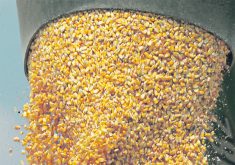After 36 hours of intense negotiations, the parties attending last week’s Cartagena Protocol on Biosafety meeting in Brazil came to a last-minute compromise on GM documentation rules that appears to satisfy nobody.
Exporters of genetically modified crops feel they have lost a long-running battle to maintain a bare-bones documentation system, a development that could disrupt future shipments of canola, soybeans and corn.
Environmental groups that were calling for stricter rules governing the trade of GM crops contend the new agreement doesn’t come close to meeting their objectives.
Read Also

Chinese, Indian tariffs take toll on pea prices
The disruption of pea exports from Canada’s largest customers will likely result in slow pea exports for the remainder of the crop year.
Those are the initial reactions to a package of detailed requirements agreed to in Brazil that replace a system where exporters of GM crops simply had to include a “may contain GMO” clause on their shipments.
Now, in addition to that clause, exporters will be required to list more specifics of what the shipment may contain, including the common and scientific name of the genetically modified organism and its transformation event code or unique identifier code.
Documentation requirements have been a major stumbling block in the implementation of the protocol, which is an international agreement to ensure the safe export of GM products that has been ratified by 132 countries.
In previous meetings a small collection of exporting nations led by Brazil caused a stalemate by refusing to endorse stricter rules. Their objections prevented the unanimity required to resolve the contentious issue.
That united opposition collapsed last week when the host country went from supporting the status quo “may contain” requirement to proposing a “contains” regime that would force exporters to implement costly testing procedures to identify exactly the various GMOs in every shipment.
“Within a couple of days Brazil moved from a leading proponent of what I’d call minimal documentation to the leading proponent for maximum documentation,” said Dennis Stephens, a consultant with the Canada Grains Council.
Through a series of strenuous objections, Mexico and Paraguay were able to water down Brazil’s proposal into a compromise package that lies somewhere between the two extremes.
Greenpeace International welcomed the new deal, although it had some harsh words for the two countries that stood in the way of Brazil’s proposal.
“Mexico and Paraguay have betrayed the aspirations of developing countries, who, despite the mild improvements in the regulations, will now be obliged to look to additional national legislation to protect themselves,” said spokesperson Benedikt Haerlin.
National Farmers Union executive secretary Terry Pugh was disappointed with the compromise that he equated to a voluntary labelling regime.
“There’s quite a few loopholes so I think it’s clear that the grain trade certainly had a hand in making sure there was no need to have mandatory labelling,” he said.
However, the grain industry contends it is less than thrilled with the outcome.
Stephens said although Canada hasn’t ratified the protocol, it will be bound by the rules of the document when shipping product to one of the 132 countries that have ratified the agreement.
Trouble could arise if Canada approves a GMO event that hasn’t been approved by an importer like the European Union. A red flag will go up if that event shows up on the list included on the shipping documents.
“Then you’ve got a major problem,” said Stephens.
But he acknowledged that in addition to avoiding costly testing regulations, Canada dodged a couple of other bullets in Brazil last week.
At one point in the deliberations the new requirements were going to apply to heritage events, which are GMOs that have been taken off the market but may still be found in some farm bins.
Including those heritage events on labels could have posed a real headache for exporters like Canada because a lot of those outdated GMOs have not been approved by many importing nations.
Stephens was relieved to see that language removed from the final text.
He is also pleased the protocol allows its 132 members to circumvent the more onerous documentation rules by entering into bilateral or multilateral trade agreements calling for the “may contain” approach.
Pugh said those types of concessions have made the new documentation rules largely meaningless. Simply listing what a shipment may contain doesn’t really tell the importing country anything, he said.
The NFU wanted to see a full testing regime along the lines of what Brazil was proposing.
“We shouldn’t just be looking for rules that just make it easy for exporters to be shipping whatever they want whenever they want,” he said.















